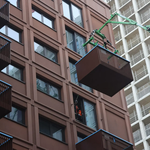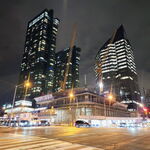[...]
Many vehicles can make use of regenerative braking, from light hybrid vehicles to hybrid and electric vehicles as large as
freight trains. The TriMet Portland/Milwaukee Light Rail Transit Line is getting a new regenerative braking system designed by
Siemens of Germany. The power recovered from bringing the train to a stop is stored in a
supercapacitor [SuperCap]. The system uses SuperCaps instead of a standard rechargeable battery pack because SuperCaps can store and deliver power in far greater capacity in a shorter amount of time.
The
Siemens’ SuperCap approach to regenerative braking in a light rail line helps to keep grid power from spiking and sagging each time the locomotive starts and stops. By storing the energy temporarily, just the amount of time the locomotive is stopped, the SuperCap can provide the power needed for quick acceleration without causing grid power to dip below acceptable levels. Just like a typical hybrid electric vehicle design, overall consumption is also reduced since most of the kinetic energy of the locomotive is recovered for use later, instead of lost as heat.
[...]





